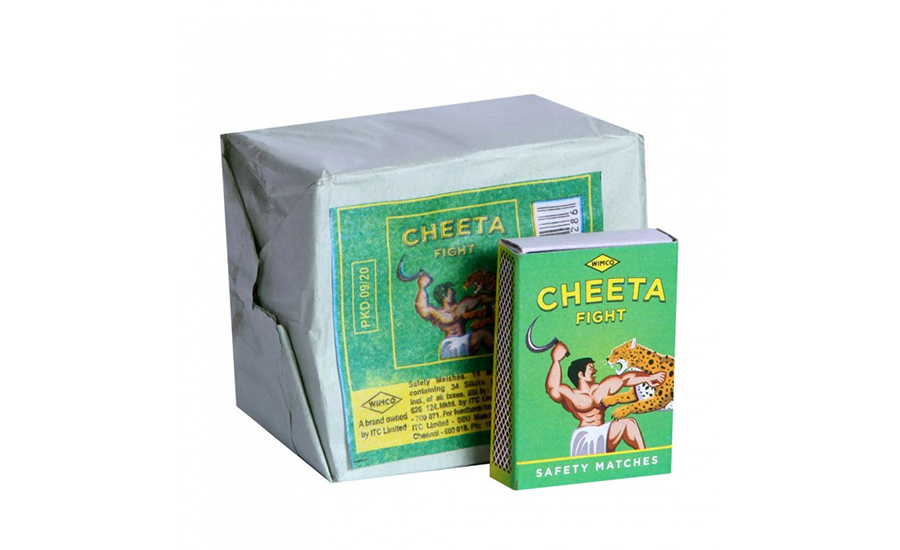
How a legend found its way to literature via a matchbox logo

Those who still keep a box of matchsticks handy in this technologically-advanced era must be familiar with the ingenious logos and monograms stamped on these little packets. But, not everyone knows that some of these logos have been inspired by extraordinary stories and in turn have inspired works of literature. One such logo is the picture of a man fighting a cheetah with a sickle, printed on the popular matchstick brand ‘Cheetah Fight Matchbox’, manufactured by Wimco Limited.
From box to book
According to legend, the image dates back to the 1930 and the man wielding the sickle was Chinna Reddy, a native of Rangavaram, a village in present-day Tiruvallur district. Reddy, accompanied by his pet dog, was keeping vigil on his banana orchard in the night when a cheetah pounced on them. Reddy retaliated and killed the beast with his sickle.
Inspired by the legend, Wimco Limited in the same decade started using the ‘Cheetah Fight’ logo in its matchboxes manufactured in Tiruvottiyur, Chennai. The place where the matchbox was located later came to be known as Wimco Nagar.
The story of Chinna Reddy’s bravery also inspired Tamil journalist-turned-writer Tamilmagan to pen his 2009 novel Vettuppuli. Keeping the legend as the central theme, Tamilmagan wove the political and film history of Tamil Nadu around it. The novel begins with three friends, Tamil Selvan, Prabash and Fernandez, all IT employees, who travel to Tiruvallur in search of Chinna Reddy, a distant relative of Tamil Selvan.
While trying to trace the roots of China Reddy, the writer explores the growth of the ‘Cheetah Fight’ matchbox, and in the process brings together the pieces of key developments in politics and cinema of the state, to provide a larger picture of Tamil Nadu during the period.
“The character Tamil Selvan in this novel is no one but me. Chinna Reddy was a distant relative of mine but our family lost contact his many years ago. When I started to pen this novel in 2009, the centenary year of Tamil cinema (2013) and the centenary year of Justice Party (2016) was nearing. So I blended facts with fiction to chronicle a story about Tamil Nadu’s political and film history through the journey of the ‘Cheetah Fight’ matchbox” Tamilmagan told The Federal.
The novel revolves around the people of Chennai and its outskirts, particularly in the Tiruvallur district and travels through the decades between 1940s and 2010, giving the reader an occasional peek into key events.
For instance, in the chapter where the novel talks about Chinna Reddy’s confrontation with the cheetah, the readers are also told about the other developments that happened in the state at the same time.
“In 1940s, the Poondi reservoir, Chennai’s first reservoir to provide drinking water to the city, was built. That was also the time, the films were projected using dhotis as screens and a guide was used to explain the characters and the gist of what is happening in the story, since the films then had no sound,” said Tamilmagan.
By the 1950s, the ‘Cheetah Fight’ matchbox, which was once used only by elite families, had become an essential item in all households. Before that people, used to borrow ‘fire’ from affluent neighbours, Tamilmagan said.
“During that decade, Periyar Thidal in Vepery, Chennai came into existence. It was earlier a tram shed. It was Kamraj, the former chief minister of Tamil Nadu, who decided to dedicate the place to Periyar, the founder of Dravidar Kazhagam,” he said.
The author says, in the 1960s, one matchbox was not enough for one bundle of beedi. But, soon, cigars started becoming popular among the affluent in India, and gas lighters reduced the use of matchsticks.
“At that time, the communists were speaking about international issues instead of focusing on issues like caste atrocities at home. The Congress was discussing about national issues. In this backdrop, it was the speeches made by the DMK leaders that attracted a large number of youth to the party,” Tamilmagan said. In films, the decade saw the arrival of filmmaker K Balachander.
Turning point
In the 1980s, karborised matchsticks were manufactured for the first time for the ‘Cheetah Fight’ label of Wimco.
“All the matchsticks were in same length and the chemical in the head of the matchsticks was evenly shaped, than in the past. Earlier, the striking surface (the sides of the matchbox) was smooth and because of that matchsticks didn’t fire easily. This time around, the surface was made dry and rough, to make the striking easier. Also, in the past, the images of the man with sickle and the cheetah were printed separately and pasted on the matchbox. But now, the whole image was embossed on the matchbox itself. In the earlier versions of the label image, one could also find the image of the dog that accompanied Chinna Reddy. In the new one, the dog’s image was removed,” Tamilmagan said.
In this decade, Tamil Nadu had witnessed enormous support for Sri Lankan Tamil’s cause. The supporters organised many rallies and staged many protests. In one such protests, Pugazhendi, the son of popular lyricist Pulamaipithan, was attacked severely during lathi charge by police. It was also the time when the Rail overbridge was constructed near Chennai’s Loyola College.
The novel finally ends with the trio finding a news report that was published on October 8, 1934 in Dinamani newspaper, which said that a man has killed a cheetah near Tiruttani, Tiruvallur. That became an evidence for Tamil Selvan, to substantiate that the story behind the ‘Cheetah Fight’ matchbox image was indeed true.


